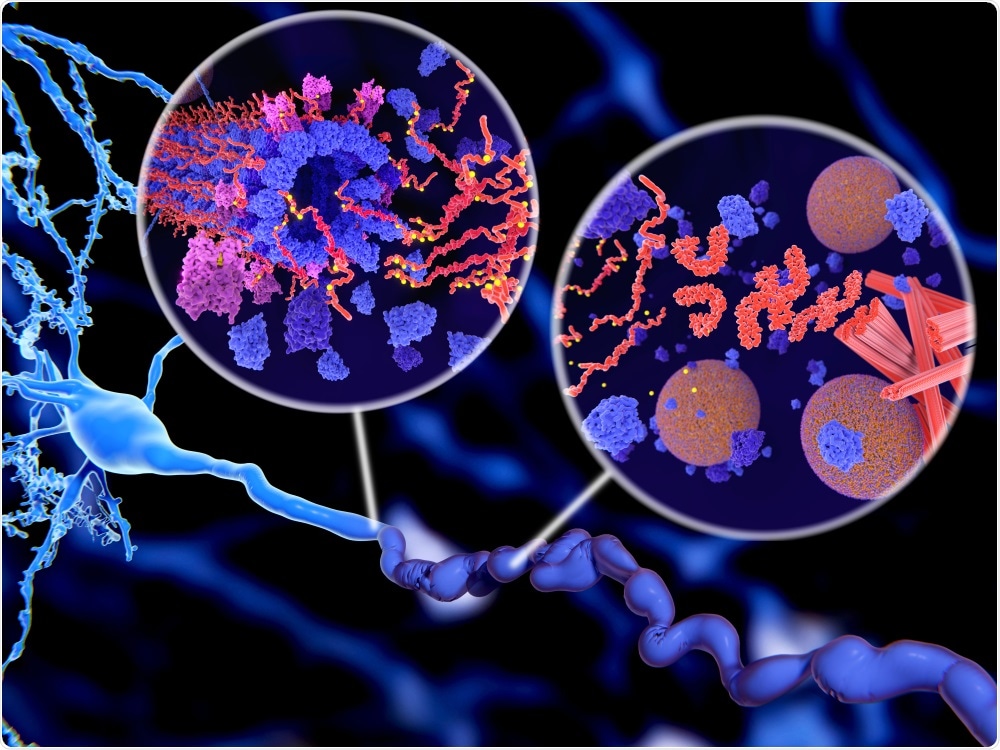Scientists have used advanced laboratory assays to show that high levels of prions are implicated in early-onset Alzheimer’s disease. The results were published in Science Translational Medicine on 1 May 2019.
 Juan Gaertner | Shutterstock
Juan Gaertner | Shutterstock
What are prions and how are they linked to dementia?
Alzheimer’s disease is a form of dementia, a group of neurodegenerative diseases caused by “toxic clumps of faulty proteins,” as defined by Alzheimer’s Society UK.
Prions, which are misfolded versions of proteins, are known to cause some rare forms of dementia. These proteins comprise an abnormally folded protein that forces normally-folded proteins to fold abnormally and change into the abnormal prion shape.
These new, abnormally-folded proteins then trigger the same changes in other proteins, and eventually form plaques that interfere with synaptic transmission in the brain (synapses are chemical junctions between adjacent nerve cells).
The resulting plaques cause nerve cells to become damage and die, eventually leading to neurodegenerative diseases such as dementia. Patients with prion-derived diseases will present with a wide range of symptoms, from impaired brain function, to changes in personality, and difficulties with mobility.
Prions were frequently seen in AD patients
The first prion protein was discovered in the 1980s by Stanley Prusiner, MD, who was the senior author of the new study. His new work saw researchers combining two laboratory tests to measure prion levels in human tissue samples.
The techniques include a new Aβ detection system created in Prusiner’s laboratory, and an assay for tau prions.
These cell-based assays can measure levels of infectious prions in three days, vastly improving the time it takes to carry out this type of research and analysis. They allowed the researchers to rapidly calculate the amount of tau and Aβ prions in post-mortem brain samples.
Over 100 samples of autopsied brain tissue taken from patients who had died from Alzheimer’s disease, among other types of neurodegenerative conditions, in the US, Europe, and Asia, were analyzed for the study.
Results showed that in 75 brain tissue samples from people who had died of Alzheimer’s, Aβ and tau prion activity was high. 11 samples from people who had died of cerebral amyloid angiopathy (CAA) only contained Aβ prions. 10 samples of frontotemporal lobar degeneration with tau pathology (FTLD) only contained tau prions.
A ‘game-changer’
It was also discovered that prion forms of tau and Aβ spread most prolifically in patients who had inherited the disease and died from it at younger ages.
In stark contrast to the common patterns seen in the disease pathway in older patients, it was also found that prion forms of tau declined significantly with increasing age, instead of increasing in older age.
A strong correlation was found between younger age and higher levels of tau prions. On average, patients who passed away at the age of 40 had tau prion levels 32 times higher than patients who passed away at the age of 90.
Co-author of the study and protein chemist William DeGrado, PhD, who is a professor of pharmaceutical chemistry and a member of the UCSF Cardiovascular Research Institute was involved with the design and analysis in the new study. He described the assays as a “game-changer”, saying that:
“Previously Alzheimer’s research has been stuck looking at collateral damage in the form of misfolded, dead proteins that form plaques and triangles. Now it turns out that it is prion activity that correlates with disease, rather than the amount of plaques and tangles at the time of autopsy.”
If we are going to succeed in developing effective therapies and diagnostics, we need to target the active prion forms, rather than the large amount of protein in plaques and tangles.”
William DeGrado
A ‘sea-change’ in Alzheimer’s disease
Prusiner also spoke on the significance of his new work.
I believe this [new discovery] shows beyond a shadow of a doubt that amyloid beta and tau are both prions, and that Alzheimer’s disease is a double-prion disorder in which these two rogue proteins together destroy the brain.
The fact that prion levels also appear linked to patient longevity should change how we think about the way forward for developing treatments for the disease. We need a sea change in Alzheimer’s disease research, and that is what this paper does. This paper might catalyse a major change in AD research.”
Stanley Prusiner
Another of the study’s lead authors, Carlo Condello, PhD, described how many “promising” treatments for Alzheimer’s fail in clinical trials. He said that this has lead “some to speculate that we have been targeting the wrong proteins.”
“But what if we just haven’t been designing drugs against the distinctive prion forms of these proteins that actually cause disease?” he continued. “Now that we can effectively measure the prion forms of Aβ and tau, there’s hope that we can develop drugs that either prevent them from forming or spreading, or help the brain clear them before they cause damage.”
It is thought that this new discovery may also influence future diagnosis, drug design and treatment, and inspire researchers to work to create treatments that directly target the Aβ and tau proteins they are now able to measure easily.